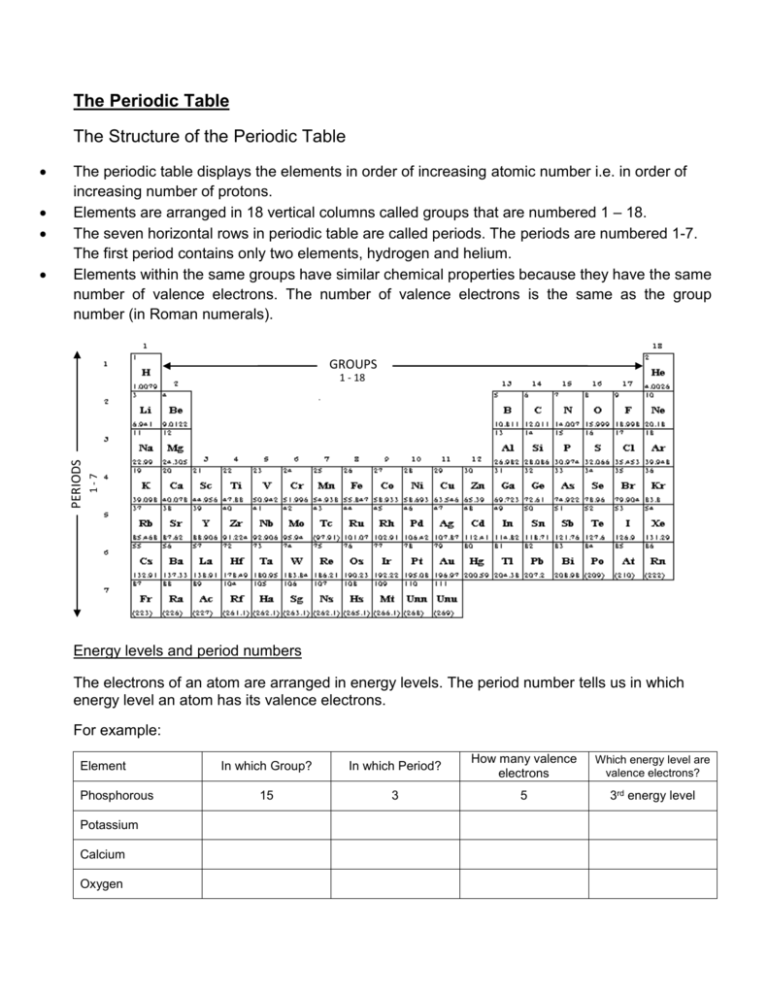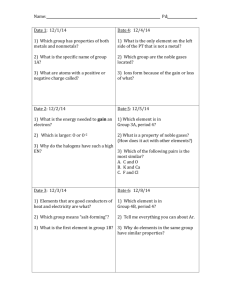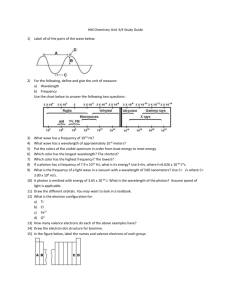Periodic Table, Periodicity, and Chemical Bonding Worksheet
advertisement

The Periodic Table The Structure of the Periodic Table GROUPS 1 - 18 1-7 The periodic table displays the elements in order of increasing atomic number i.e. in order of increasing number of protons. Elements are arranged in 18 vertical columns called groups that are numbered 1 – 18. The seven horizontal rows in periodic table are called periods. The periods are numbered 1-7. The first period contains only two elements, hydrogen and helium. Elements within the same groups have similar chemical properties because they have the same number of valence electrons. The number of valence electrons is the same as the group number (in Roman numerals). PERIODS Energy levels and period numbers The electrons of an atom are arranged in energy levels. The period number tells us in which energy level an atom has its valence electrons. For example: Element Phosphorous Potassium Calcium Oxygen In which Group? In which Period? How many valence electrons Which energy level are valence electrons? 15 3 5 3rd energy level Exercise: Find the element described below, state how many valence electrons it has and write down the electron configuration notation for each one: 2.1 Element in Period 1, Group 18 2.2 Element in Period 3, Group 14 2.3 Element in Period 2, Group 13. Periodicity in properties of elements Periodicity is the gradual change of physical and chemical properties as we move across the periodic table. The periodic law states that many of the physical and chemical properties of the elements tend to follow a pattern with increasing atomic number. The periodic table shows how the periodicity of the physical and chemical properties of the elements relates to their atomic structure. ‘ Atomic radius The atomic radius of an element is the term used to describe the size of an atom. The atomic radius is the distance from the nucleus to the outermost stable electron orbital. The size of atoms decreases as you go across a period because, while new electrons are being added to the atoms, new protons are also being added to their nuclei. This increased positive charge holds the negative electrons more tightly. At the beginning of the next period, electrons enter a whole new energy level and the atom increases in size. Atomic radius increases down a group because energy levels are added in each new period. Melting point, boiling point and density of elements The physical properties of elements - such as the melting point, boiling point and density vary periodically. Periodicity in Ionization Energy It takes energy to remove an electron from an atom. This energy is called ionization energy and it is measured in kilojoules per mole (kJ.mol-1). The first ionization energy is the energy required to remove the first, most loosely held electron from an atom. Across each period there is an increase in first ionization energy. As you go across a period, the atoms are getting smaller and thus the negative electrons are closer to the positive nucleus. Also the size of the positive charge in the nucleus is getting bigger. The result is that the valence electrons are held more tightly by the nucleus. Thus the first ionization energy has to be bigger to remove a first electron. The first ionization energy reaches a maximum with Group 18 elements. Down each group there is a decrease in first ionization energy as you go down a group, the valence electrons in the outermost energy level of the atoms are further away from the positive nucleus. The valence electrons are screened (or shielded) from the positive nucleus by the core electrons. This means that the electrons are held less tightly as you go down a group, and less energy is needed to remove one. Graph showing trends in ionization energy for the 1st twenty elements Influence of periodicity on electron affinity Electron affinity is the energy change that occurs when an atom or molecule gains an electron to form a negative ion. When gaining an electron the atom gives off energy so the sign of the energy change is negative. The greater the amount of energy released (the more negative the energy value); the more likely an atom will want to gain an electron. Electron affinities become more negative as we move from left to right across a period (Except for noble gases. Why?) Electron affinities change little moving down a group, though they do generally become slightly more positive (less attractive toward electrons). Electronegativity Electronegativity is a measure of how strongly the atom attracts the shared pair of electrons in a chemical bond It is affected by both its atomic number and the distance of its valence electrons from the nucleus. Electronegativity generally increases moving across a period and decreases moving down a group. Fluorine (F) in Group 17 and Period 2 is the most electronegative of the elements. The chemical properties of elements in the same group are similar because valence electrons determine the chemical properties of an element. Electron arrangement Each element in a group has the same number of valence electrons A full outer energy level with eight electrons is relatively stable, so many atoms lose or gain electrons to obtain an electron configuration like that of the nearest noble gas. This is called the octet rule. The octet rule states that atoms tend to combine in such a way each have eight electrons in their outer energy level, giving the electron configuration as a noble gas. Reactivity of the Groups 1, 2, 17 and 18 Reactivity is a measure how vigorously an atom will react with a substance. This is usually determined by how easily electrons can be removed (ionization energy) or how strongly the element attracts the other electrons (electronegativity). Group 18 elements do not react. These elements are very stable. said to be inert. In Group 1 and 2, reactivity decreases as you go from left to right across the period and increases as you go down a group. In Group 17, reactivity deceases as you go down the group. Chemical properties of Group 1 elements: the alkali metals The alkali metals are all highly reactive. These elements are stored under oil. If alkali metals come into oxygen (in the air) or water (also water vapour in the atmosphere) they react vigorously and spontaneously. When an alkali metal reacts with oxygen it will form a metal oxide Example: sodium (Na) + oxygen (O2) sodium oxide (Na2O) When an alkali metal reacts with water, it will form a metal hydroxide and hydrogen gas. Example: potassium (K) + water (H20) potassium hydroxide (KOH) + H2 (g) Chemical properties of Group 2 elements: the alkaline-earth metals The alkaline-earth metals are not as reactive as the alkali metals Alkaline—earth metals react slowly with the oxygen in the air to form a layer of metal oxide on the surface: The alkaline-earth metals burn easily when in powder form or as a flat ribbon if placed in a flame. Example: beryllium (Be) + oxygen (O2) beryllium oxide (BeO) They react easily with halogens to form metal halides. Example: magnesium (Mg) + chlorine (Cl2) magnesium chloride (MgCl2) Chemical properties of Group 17 elements: the halogens Halogens, which are non—metals, are always found as diatomic compounds The halogens have very high electronegativities The halogens are very reactive with the alkali metals and alkaline-earth metals Chemical properties of Group 18 elements: the noble gases The noble gases are all found in minute quantities in the atmosphere They are all odourless, colourless, monatomic gases. They are inert and do not react chemically. Chemical Bonding and Lewis Diagrams Atoms are held together in molecules by chemical bonds. Similarly ions are held together in crystals. Lewis diagrams are used to represent the valence electrons of an atom. They Lewis diagram: diagram also show the electrons involved the chemical bond between two atoms. When we write a Lewis diagram for an atom, the chemical symbol for the element is used to represent the element and its core electrons. The valence electrons are represented by dots arranged around the core. The electrons that are paired in an orbital are shown as a pair of dots. Electrons that are unpaired in the orbital are shown as a single dot. We use the electron configuration and Aufbau diagrams to help draw Lewis diagrams. Worked example 1 Write down the electron configuration notation of the valence electrons notation and draw the Lewis diagram for: (1) Sulphur (2) Calcium (3) Oxygen







